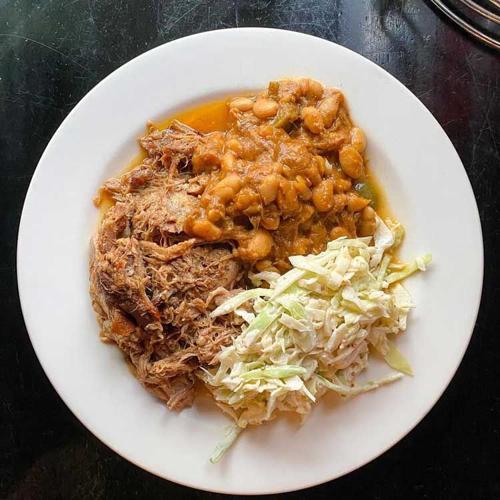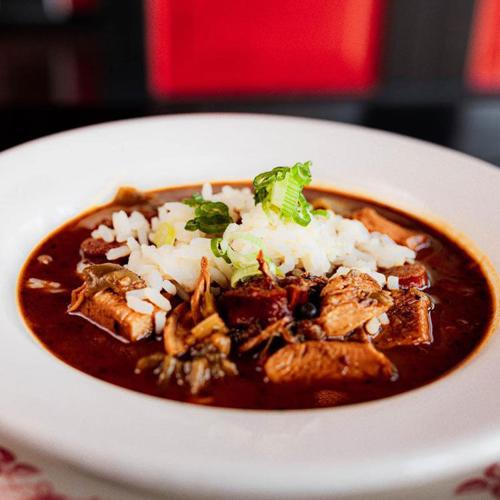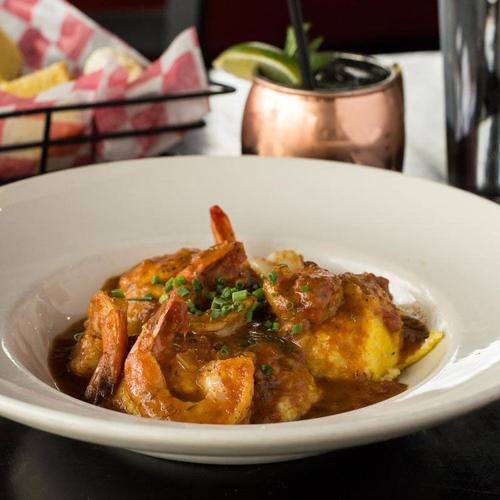
Maxie's shrimp and grits.
Cajun, Creole, BBQ … many people see these cuisines as one, but according to Dan Sidner, co-owner of Maxie's and Black Shoe Hospitality, that hasn't always been the case.
Sidner, an expert in the history of Southern food, has been an owner of restaurants in North and South Carolina, Louisiana and Texas. When he moved to Milwaukee, he met Joe Muench — his business partner for Black Shoe Hospitality — and together they opened Maxie’s in 2007, Blue's Egg in 2010, Story Hill BKC in 2014 and Buttermint in 2021.
Though the cuisines are often melded together — especially Cajun and Creole — there are actually distinct historical differences between them, he says. It wasn't until the 1960s when Paul Prudhome, a well-known New Orleans chef, became the head chef of Commander's Palace that the two cuisines became more intertwined.
The move was actually a controversial one, as Commander's Palace traditionally only employed Creole chefs. Prudhome was the first Cajun chef to take the reins and was so successful that he later opened his own restaurant on Bourbon Street, K. Paul LA Kitchen, and started his own seasoning company: Paul Prudhome's Seasoning.
So where did these comfort food favorites — mac and cheese, cornbread, pulled pork, jambalaya — really come from? Sidner shared some facts about Southern foods' roots.
Cuisine: Creole
According to the National Park Service, Creole heritage refers to people who were born in Louisiana with ancestry in France and Spain. Though Creole often gets intermingled with Cajun because of their close proximity in the south, their dwelling places are actually responsible for many of their differences, Sidner says. Creole people lived in cities, whereas Cajun people — originally French Canadians — lived in the swamp. Creole food is therefore considered to be a more refined cuisine than Cajun, he adds.
Traditional Creole food often included ocean fish, because fishermen were able to take out boats to catch them, whereas Cajun cooking relied on shellfish that could be caught from shore, Sidner says. Creole food is also heavy in spice from its French European roots and African influences from those in slavery in the South. Jambalaya and red beans and rice are some of the more popular Creole dishes.
Try this classic Creole dish:
Jambalaya. Jambalaya can actually be a Cajun or a Creole dish depending on how it's prepared, Sidner says. A Creole jambalaya, like the one Executive Chef Jacob Schick prepares at Maxie's, uses a tomato-based Creole sauce, whereas a Cajun jambalaya relies on heavy seasoning when preparing the dish.
Cuisine: Cajun
Sidner says after getting "basically kicked out" of Eastern Canada, the Cajuns spent the next 40 years working their way down the American coast looking for a home. Their struggle to put down roots was likely due to their religious ideas around communal living that included sharing partners, an idea that was unpopular among the Puritan settlers, he says. Ultimately, the Cajuns landed in the swamp of Louisiana.
As a result, a defining factor of Cajun food became ingredients that were either found in or easily grown in the swamp, a challenge for many vegetables outside of the hearty pepper. Pork, shrimp, shellfish and wild game were all easily accessible protein options. The majority of Cajun flavoring comes from steps taken to cure meats versus seasoning them later on, as in Creole cooking, Sidner says.

Maxie's Gumbo.
Try this classic Cajun dish:
Gumbo. This heavily-seasoned dish is one of the more well-known Cajun classics. Maxie's gumbo has a Cajun preparation. It's made with a roux and a lot of heavily-seasoned chicken, andouille sausage and shrimp — popular Cajun inclusions.
Cuisine: BBQ
When people think of BBQ, Sidner says most people imagine Kansas City-style sauce made with tomato, molasses and brown sugar. But depending on which part of the South you're dining in, BBQ can vary quite drastically from cuts of meat to type of sauce, he says.
For example, in North Carolina, he says you'll eat “the whole hog,” whereas in Tennessee, animals are broken down much more. In Kansas City, you'll get sweet, soupy sauce, whereas in eastern North Carolina you'll get a vinegar-based sauce. So, like Southern food, BBQ can have quite a bit of variety depending on its place of origin.

Maxie's NC pulled pork.
Try this BBQ dish:
North Carolina pulled pork. Based on the BBQ styles of eastern North Carolina, Maxie's BBQ sauce is a vinegar-based sauce, which pairs especially well with the fatty pork meat because of its acidity, Sidner says. It's made with vinegar, shallots, garlic, white pepper and black pepper and tossed with pulled pork, served on a bed of coleslaw and BBQ beans.
Cuisine: Lowcountry
The marshy, sandy soil of the outer banks of North Carolina (and through the islands of Georgia) is difficult to grow in, but there's an abundance of wildlife and incredible seafood offerings, Sidner says. As Spanish settlers traveled to North Carolina, they'd often stop in Bermuda, which was controlled by Britain at the time. Therefore, Sidner says, Lowcountry cooking has a strong English influence. West African influences from the Gullah Geechee — descendants of slaves with roots in the Lowcountry — are responsible for key Lowcountry ingredients like okra, tomatoes, greens and sweet potatoes, according to Discover South Carolina. Stews and soups are some of the anchor dishes of this cuisine.
Try this classic Lowcountry dish:
Shrimp and grits. Maxie's version of this Lowcountry classic is prepared with a spiced tasso sauce (made from a smoked ham). When it's delivered to the restaurant, “we don't just wear gloves, we're wearing goggles because it's so spicy,” Sidner says. Only 3-4 ounces will ultimately make a couple gallons of gravy, he says. But the result is a sauce that is savory and abundantly flavorful. Though the tasso technically doesn't make Maxie's shrimp and grits authentically Lowcountry, the combination of flavors is absolutely delicious. MKE
The Staples Of Southern Cooking
Corn: Indigenous Americans introduced early settlers from France and Spain to this hearty vegetable that has become the backbone of many favorite country classics. Grits, cornbread, hush puppies and various versions of creamed and seasoned corn are popular sides for Southern dishes. And corn is a critical ingredient in arguably one of the best pairings to Southern food: bourbon.
Rice: Rice is a huge component of Southern food, Sidner says, because it grows so ubiquitous in the South. Many dishes are served over rice or incorporate rice. According to Discover South Carolina, enslaved people in the South cooked rice for their own sustenance, starting slow-boiling pots before beginning a day of work. Now, it's a traditional staple of many southern dishes.
Seafood: Since the majority of the Southern food originated along the water, seafood was an important part of the cuisine. And because shrimp and crawfish could be easily caught close to the shore, Cajuns incorporated lots of shellfish in their dishes, Sidner says. Creoles were able to afford boats to catch fish, which explains why so many different types of fish worked their way into the Creole menu.
Heavy spice: According to MasterClass, Cajun seasoning often includes black paper, white pepper, cayenne pepper, onion powder, garlic powder and paprika, whereas Creole food tends to lean toward black pepper, garlic powder, onion powder, cayenne pepper and herbs such as dried thyme, basil and oregano. This unique mix of spice can be traced back to the route settlers took to the states — when boats headed for the U.S. stopped in the Caribbean to pick up additional travel provisions, European settlers picked up African spices and begin working them into their dishes, Sidner says.
Crawfish Étouffée Recipe
Courtesy of Jacob Schick, executive chef at Maxie's
"A fresh side salad is a great accompaniment with this dish," Schick says.
Ingredients:
½ cup red bell pepper
½ cup green bell pepper
½ cup yellow onion
½ cup celery
1 tbsp. garlic
2 tbsp. butter
1 tbsp. Cajun seasoning
½ cup flour
2 cups shellfish stock
½ cup white wine
1 cup crushed tomato
1 tbsp. Worcestershire
1 tbsp. Tabasco hot sauce
Pinch salt
Pinch pepper
1 lb. crawfish (can substitute with shrimp, but really prefer crawfish)
1 tbsp. canola oil
Directions:
• Dice veggies. Melt the butter in a sauce pot, and add diced veggies. Season with Cajun seasoning. Sauté until veggies become soft and translucent. Add flour. Stir and cook flour for a couple of minutes.
• Whisk in the stock slowly and stir aggressively to incorporate into the flour. Once smooth, add white wine and crushed tomatoes. Add seasoning and reduce for 10 minutes, until sauce becomes slightly thick.
• Sauté crawfish in oil in a hot sauté pan for 1 minute. Add sauce and let simmer for 2 minutes.
• Serve over rice, pasta or toasted bread. Serves 4.



